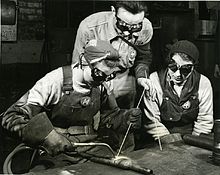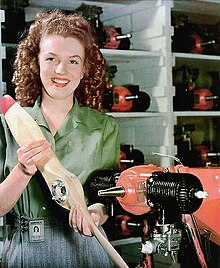Rosie the Riveter
The fictional person Rosie the Riveter (German: Rosie, die Nieterin ) was the main character of a propaganda film by the US War Information Office for recruiting women into the arms industry and eponymous heroine of a popular US song. She became the cultural icon of this advertising campaign, which symbolized the women who worked in the armaments industry by the thousands during World War II .
It still plays a role as a symbol for working women and as a feminist symbol for economic strength; she inspired films and book publications. The poster We Can Do It! Was only briefly used internally by the Westinghouse Group during the 1942 war . by J. Howard Miller (1918–2004) was not associated with the campaign until the 1980s and then reproduced millions of times on coffee cups, matchboxes and paper.
Campaign for women in the war industry
The fictional character Rosie the Riveter was created against the background that the importance of women for war-important companies had been recognized. In 1941 the United States Office of War Information developed an advertising campaign aimed at recruiting young American women to work in war industries. The campaigns at that time were aimed primarily at housewives under the motto who can operate an electric mixer, can also handle a drill. It also included the husbands who were taught to be proud of their able wives. Rosie the Riveter became the icon of this advertising campaign as the personified patriot.
Associated with the Rosie the Riveter campaign is the rapid increase in the number of working women in the United States, from 12 million to 20 million between 1940 and 1944. However, most of them were not employed in production but in offices and writing rooms. In 2000, the Rosie the Riveter / World War II Home Front National Historical Park was opened in Richmond, California on the site of a former large shipyard. Over 200 former Rosies attended the opening. In 1944, the motif was filmed as Rosie the Riveter and was also the subject of a 1980 Connie Field- produced documentary called The Life and Times of Rosie the Riveter .
iconography
music
The term "Rosie the Riveter" was used in a 1942 song by Redd Evans and John Jacob Loeb. The song was played by Kay Kyser , among others , and became a popular hit nationwide. The name may go back to Rosie Bonavitas, who worked at Convair in San Diego , California . The motif was similar to Veronica Foster , who was immortalized in Canada in 1941 as Ronnie, the Bren Gun Girl .
The image initially associated with the song was linked to Rose Will Monroe, who was from Pulaski County , Kentucky and worked on B-29 and B-24 at the Willow Run Aircraft Factory in Ypsilanti , Michigan . Monroe was portrayed in a commercial and identified with the song "Rosie the Riveter".
photos
The pictures themselves often show an idealized representation of the working women, the sometimes precarious working conditions are hidden. The enormous mobilization and motivation of women in general, as well as considerable progress in the recognition of black women workers, are unaffected. Leila J. Rupp examined differences and similarities to the German, much less pronounced propaganda in the field, which, according to her, was hardly able to mobilize the potential of the female workforce in contrast to the USA. Regardless of this, the traditional images of women were still rumored in both countries.
A Rosie on an A-31 bomber
Working on the Plexiglas cockpit of a Boeing B-17
The hairstyle style attributed to Rosie typically consisted of pinned up hair and accessories to protect the hair such as headbands, looped kerchiefs or turbans so as not to injure oneself when working on machines and moving parts. The typical 40s updos consisted of different elements such as rolls, curls, waves and pompadours. In the USA, the very popular hairstyle with two opposite roles was called Victory Rolls (winning roles, after a flight maneuver or after the V-shape of the hairstyle). In Germany, the expression “all-clear hairstyle” (all up) came into use, and updos were fashionable across borders.
Image by Norman Rockwell
Inspired by the song "Rosie the Riveter", Norman Rockwell painted the oil painting "Rosie the Riveter" based on a photo by 19-year-old operator Mary Doyle (Keefe). Then a worker takes her lunch in a pose based on the prophet Isaiah in the Sistine Chapel, painted by Michelangelo . Her name is on the lunch box, the riveting machine is on her lap ready for further work, her foot rests on Hitler's Mein Kampf , her strongly depicted arms can be interpreted as Isaiah's destructive power against evil, with her application of lipstick she appears feminine and forms the background the American national flag. In May 1943, the picture was featured on the cover of The Saturday Evening Post with a circulation of 3 million. The painting is on display at the Crystal Bridges Museum of American Art in Bentonville and was bought at auction house Sotheby in 2002 for just under $ 5 million.
The Westinghouse “We Can Do It!” Poster
In 1942 J. Howard Miller began designing a series of posters for the arms industry at the Westinghouse Company. One of the posters was titled We Can Do It! only produced for Westinghouse. It was presented in a run of just under 1,800 within Westinghouse's Pennsylvania and Midwestern factories in a two-week morale series in February 1943 and was quickly forgotten. The picture, in the national colors of blue, red and white, developed decades later into a popular and widespread symbolic figure of the industrial peacemaker, feminism and patriotic home front solidarity . How the image got back into the public eye is unclear, in 1982 a reprint appeared in the Washington Post and in 1994 it appeared on the front page of Smithsonian Magazine and is very popular without most people knowing the origins. It wasn't until decades after the war that it was transfigured into a Rosie the Riveter . The picture contains no reference to the female name Rosie or the riveting activity and Ed Reis, historian at Westinghouse, suggested in 2003 that it could more precisely be called Molly the Mycarta Molder or Helen the Helmet Liner Maker . While the then 17-year-old Geraldine Hoff (later Doyle) was the model for the picture for decades, it has been assumed since 2015 that it was the then 20-year-old Naomi Parker (1921-2018).
Marilyn Monroe as Rosie
In the fall of 1944, David Conover, an army photographer for the First Motion Picture Unit , was commissioned by his captain, later US President Ronald Reagan , to "take animating pictures of attractive women on the assembly line who support the war effort through their work." In the assembly department of an armaments factory he discovered a young woman named Norma Jeane Dougherty who had been working there for six months. The first photos appeared in the US Army's Yank magazine in mid-1945 . Conover recognized Norma Jeanes talent and advised her to apply as a model . This was the beginning of a career that would make her world famous under the stage name Marilyn Monroe .
Movies
- Norman Rockwell, Rosie the Riveter . Khan Academy.
- The Life and Times of Rosie the Riveter . Connie Field, USA 1980.
literature
- Margaret Bourke-White: Women In Steel: They are Handling Tough Jobs In Heavy Industry. In: Life , August 9, 1943.
- Constance Bowman: Slacks and Calluses - Our Summer in a Bomber Factory. Smithsonian Institution, Washington DC 1999.
- D'Ann Campbell: Women at War with America: Private Lives in a Patriotic Era . Harvard University Press, 1984
- Mary Hresko, Mary Vincher Shiner: Women Workers in World War II. May 21, 2001.
- Donna B. Knaff: Beyond Rosie the Riveter: Women of World War II in American Popular Graphic Art . University Press of Kansas, 2012
- Margaret Regis: When Our Mothers Went to War: An Illustrated History of Women in World War II. NavPublishing, Seattle 2008, ISBN 978-1-879932-05-0 .
- Susan Ware: Modern American Women A Documentary History . McGraw-Hill, 2002.
- Nancy Baker Wise, Christy Wise: A Mouthful of Rivets: Women at Work in World War II. Jossey-Bass Publishers, San Francisco 1994.
- Anna Bornstein: 'Dolly' Gillan. Woman Welder / Shipbuilder in World War II . Winnie the Welder History Project. Schlesinger Library, Radcliffe College. February 16, 2005.
- Rosie the Riveter Collection, Rose State College, Eastern Oklahoma Country Regional History. Center. [Rosie the Riveter Collection, Rose State College] March 16, 2003.
- Rosie the Riveter Redd Evans and John Jacob Loeb. Paramount Music Corporation, 1942.
- Regional Oral History Office / Rosie the Riveter / WWII American Homefront Project The Regional Oral History Office at the Bancroft Library of the University of California
Web links
- Rosie the Riveter World War II / Home Front National Historical Park
- Rosie the Riveter on the History Channel
- Regional Oral History Office / Rosie the Riveter / WWII American Homefront Project
- American Rosie the Riveter Association
- The Life and Times of Rosie the Riveter to the movie
- Oral history interview with Audrey Lyons, Veterans History Project at Central Connecticut State University
- Oral history interview with Mary Doyle Keefe, Veterans History Project at Central Connecticut State University
- Example of a playback of the song
- Ask History: Rosie the Riveter
Individual evidence
- ↑ a b c d Christof Mauch: The hundred and one most important questions - American history . Beck's series. Verlag CHBeck, 2008, section “Who was Rosie the Riveter”, p. 92 ff.
- ^ W. Raymond Duncan, Barbara Jancar-Webster, Bob Switky: World Politics in the Twenty-first Century Brief. , Student choice ed. Edition, Houghton Mifflin College Div, Boston 2008, ISBN 978-0-547-05634-0 , p. 268.
- ^ Kennett, Lee: For the duration ...: the United States goes to war, Pearl Harbor-1942 . Scribner, New York 1985, ISBN 0-684-18239-4 .
- ^ Robert Sickels: The 1940s . Greenwood Publishing Group, 2004, ISBN 978-0-313-31299-1 , p. 48.
- ^ William H. Young, Nancy K. Young: World War II and the Postwar Years in America: A Historical and Cultural Encyclopedia, Volume 1 . ABC-CLIO, 2010, ISBN 978-0-313-35652-0 , p. 606.
- ↑ Stephen E. Ambrose: The Good Fight: How World War II Was Won . Simon and Schuster, 2001, ISBN 978-0-689-84361-7 , p. 42 (accessed February 5, 2013).
- ↑ Ronnie the Bren Gun Girl . In: Toronto Star , March 15, 2010. Retrieved April 8, 2013.
- ^ Leila J. Rupp: Mobilizing Women for War: German and American Propaganda, 1939-1945 . Princeton UP, Princeton 1978, ISBN 0-691-04649-2 .
- ↑ 40s Hairstyles - Hollywood Waves, Chignon, Victory Rolls In: Retrochicks , June 3, 2013.
- ^ Art, Icons, Women's Rights: "Rosie The Riveter" 1941-1945 . Pop History Dig February 28, 2009, accessed October 13, 2019.
- ^ Report on the painting to the Rosie the Riveter Association
- ^ A. Alex: The real truth behind the iconic “We Can Do It” poster . Vintage News, August 2, 2016, accessed October 5, 2019.
- ^ Peter Kelley: Documents that Changed the World: 'Rosie the Riveter' poster, 1943 . University of Washington News, February 2, 2015, accessed October 5, 2019.
- ^ "Rosie the Riveter" is not the same as "We Can Do It!" . Docs populi, accessed October 14, 2019.
- ↑ The model for the poster icon is dead . Mirror online
- ↑ Section “The Photo Model”. marilynmonroe.de
- ↑ Marilyn, Rosie 'Monroe . The Pop History Dig; Retrieved June 23, 2013.
- ↑ Donald Spoto: Marilyn Monroe. The biography . Wilhelm Heyne Verlag, Munich 1993, ISBN 3-453-06919-6 , pp. 94-95.






